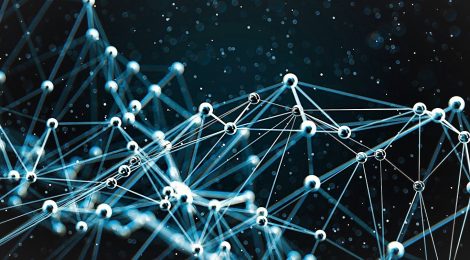
Weyl-Kondo Quantum Semi-Metal Defines Deuterated Palladium
It may have taken 30 years to explain Cold Fusion, but better late than never
An international team of physicists has just now “stumbled upon” an entirely new quantum material, which they have called “Weyl-Kondo semi-metal”.
In these quirky materials scientists don’t necessarily have the theories to predict the behaviour of such quantum materials, more often they create them experimentally first and measure them to observe their properties hoping the observations of new facts might one day lead to new theories.
Are we heading back to the roots of physics where observation of mysteries comes first and theory only thereafter?
The new findings, published in the journal Proceedings of the National Academy of Sciences, come from a team at the Vienna University of Technology carrying out experimental work to develop new materials, and a team at Rice University carrying out theoretical work.
‘We really just stumbled upon this, suddenly, we found that the mass (of material in hand) had gone from like 1,000 times the mass of an electron to zero,’ said Dr Lai.
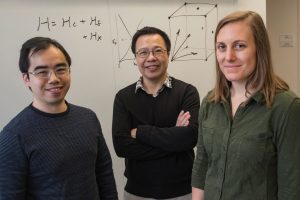
Rice University physicists (from left) Hsin-Hua Lai, Qimiao Si and Sarah Grefe have made predictions that could help experimental physicists create the first “Weyl-Kondo semimetal.” Credit: Jeff Fitlow/Rice University
This is a definitive atom-ecology phenom characteristic of “Weyl fermions”, elusive particles first proposed over 80 years ago. The scientists understood that their spooky particles were originating due to a phenomenon known as the “Kondo effect”, leading them to name their new material Weyl-Kondo semi-metal. Another characteristic of this ‘quantum material’ are its powerful interactions, beyond the potency of interactions defined or even predicted by standard physics.
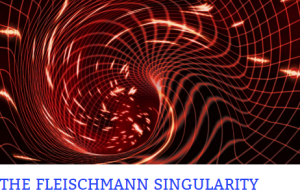
Cold Fusion created a firestorm of dogmatic controversy in the world of physics, it was and is outside of the box of simple physics and demands a quantum mechanism… click to read more
The key to the new quantum material? Palladium, or rather doped palladium. Its a good starting point as palladium when doped with other elements such as deuterium has already shown the extraordinary characteristic of suddenly becoming a super-conductor another of the Weyl-Kondo expected characteristics.
Herein begins some interactive thinking on why these new quantum materials are important.
Of course the anomalous results of the late great Martin Fleischmann and his colleague Stanley Pons are perhaps the most unexpected characteristic of their favoured ‘quantum-material’ atom-ecology.
March 29, 1989
You might recall the momentous announcement of the findings of Pons & Fleischmann following approval for publication of their first paper in the prestigious Journal of Electroanalytical Chemistry…. their discovery became known as ‘COLD FUSION.’

Martin Fleischmann holding one of his cold fusion cells during the March 1989 press conference. Click to read the original press release
The announcement of the room temperature fusion back in March of 1989 drew immediate attention around the world. It was so inexplicable that famous Nobel Laureates in Physics including Glenn Seaborg, Linus Pauling, and Edward Teller soon declared that the effect must be a quantum effect. Such a quantum effect could allow for the screening of the normal Coulomb repulsion that keeps hydrogen nuclei from getting near enough to spontaneously fuse.
In November 1989, the Energy Research Advisory Board of the Department of Energy in the United States made five recommendations regarding Cold Fusion, among them, to check for the production of helium and of tritium in the electrolyte in which cold fusion was supposed to have occurred.
Helium, especially 4He, and tritium have appeared in many cold fusion experiments in Japan, Italy, Russia, USA, Canada, India and China, and according to Li Xing Zhong at Tsinghua University Beijing China, it is one of the strongest pieces of evidence for condensed matter nuclear reactions, as it implies a new mechanism operating at low temperature: selective resonance tunnelling (a quantum effect).
Here’s a link to a report in the Magazine WIRED revealing my finding of 4He in a controlled experiment. Side by side in real-time over 28 days helium was measured in palladium dust exposed to normal hydrogen, the control, and deuterium the active cold fusion reactor. The graph pictured is a spoiler for the report, it clearly meets the demands of the US DOE committe that asked to see the ‘nuclear ash’, in this case helium from cold fusion. (Of course the mere presence of proof isn’t sufficient to promote to market truly transformative technoligies that can replace the dirty fuels of the fossil fool age, Old King Coal and his minions have been and remain bound to trump such egalatarian technologies.)
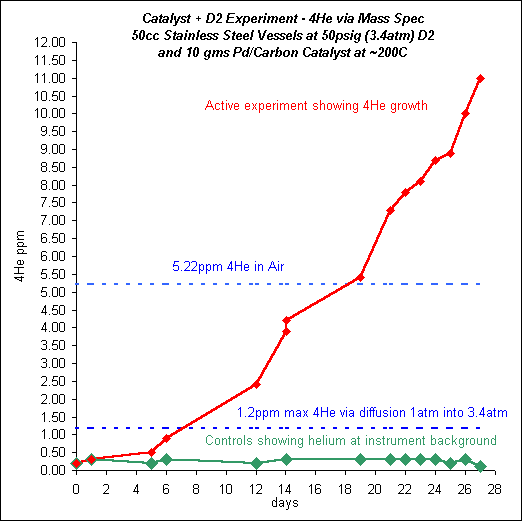
Here’s a sample of data showing a rise in 4He in a simple “cold fusion” experiment. Across the bottom in green is one set of data points where simple hydrogen was loaded into palladium, the red data set shows the identical experiment running deuterium gas. By simply heating the materials to 200 C abundant helium is produced. Experiment conducted at Stanford Research by Russ George sponsored by the Electric Power Research Institute, Palo Alto.
“The word quantum in quantum materials means they have properties that cannot be described by classical physics – we have to invoke quantum physics,” said Dr Amalia Coldea, a quantum materials researcher at the University of Oxford remarks of this new finding.
While this new research may still be of interest primarily to other quantum researchers, lead author Prof Buehler-Paschen is clear about where it could ultimately lead.
“Currently we design these materials to find new effects,” she said. “We search for them because these effects could be very useful, with technological applications.”
Practical Quantum Material Technologies
The most celebrated quantum materials are the high-temperature superconductors discovered in the 1980s, so named for their ability to conduct electrical current without resistance at temperatures well above those of traditional superconductors. Deuterated palladium is just such a superconductor.
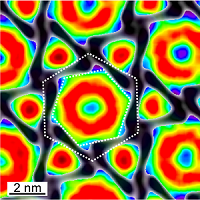
A complex electron confinement pattern in a 2D-chiral kagomé superlattice obtained via molecular self-assembly on the Ag(111) surface. Deuterated Pd is electronically very similar to Ag. Click to follow the trail.
Another classic example is the heavy fermion materials discovered in the late 1970s. In these, electrons appear to be effectively hundreds of times more massive than normal and, equally unusual, the effective electron mass seems to vary strongly as temperature changes.
Might it be that these massive collections of ‘quantum electrons’ inside of the ultra-dense semi-metallic deuterium, that is the natural state of deuterium when it is highly loaded into a palladium lattice, is responsible for ‘cold fusion.’ Clearly along all of the internal surfaces in the metal lattice — these crazy particles, mischugenons , as Edward Teller referred to them, mimic here-to-fore unidentified primary particles, some hybrid form of lepton in between a neutron and a muon++, might well be in their ideal natural habitat. They would be the perfect facilitator of ‘cold fusion.’
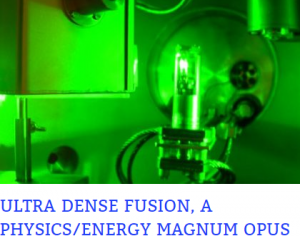
“Mesons from Laser-Induced Processes in Ultra Dense Hydrogen H(0)” – Leif Holmlid – Published: January 12, in PLOS ONE. It seems a very unusual form of ultra dense fusion is in hand in an incredibly simple to reproduce form with all the precision particle physics anyone might ever demand to substantiate it. CLICK TO READ MORE
Pioneer Science
A scant few experimentalists and even fewer theoretical physicists have dedicated their careers to explaining the workings of such quantum materials. Much of the theoretical work focuses on the collective behavior that emerges in electronic materials undergoing transformation from one quantum state to another. It is near such points of transformation, or “quantum critical points,” that phenomena like high-temperature superconductivity and associated cold fusion effects are observed to occur.
These ‘quantum materials’ share some of the characteristics of topological insulators, a type of quantum material that gained international attention following the awarding of the 2016 Nobel Prize in Physics. Topological materials have only been defined in insulators, and electricity would flow only on the materials’ surface and not through the bulk. The topological conductors, however, carry electricity in the bulk, thanks to the Weyl fermions or Mischugenons.
“These topological conductors can be described within the textbook framework of independent electrons,” Grefe said. “The central question, as challenging as it is fascinating, is this: What happens when the electron correlations are strong?”
Si, Lai and Grefe demonstrated that their zero-mass fermions are intimately tied to both strong electron correlations and nontrivial topology.
“We quickly realized that these are Weyl fermions that originate from a quintessential strong-correlation physics called the Kondo effect,” Grefe said. “We therefore dubbed this state a Weyl-Kondo semimetal.”
The Kondo effect captures how a band of electrons, which are so strongly correlated with each other that they act as localized spins, behave in a background of conduction electrons.
“We found that the Kondo effect makes the Weyl fermions move with a velocity that differs by several orders of magnitude from the noninteracting case,” Lai said. “This allowed us to predict that the electron correlations will enhance a particular quantity in the temperature dependence of the specific heat by a mind-boggling factor of a billion.”
Effectively these massive quantum electron clusters combined with the characteristic that they are behaving at room temperature rather like they were a billion times hotter is the very bridge classical HOT FUSION had demanded for COLD FUSION to exist. One might even consider them as an example of quantized inertia.
Two miracles
There remain some mysteries in cold fusion amongst which are the clearly missing highly energetic radiations that accompany typical HOT FUSIONS of deuterons, but that’s another part of the story, stay tuned. OK I’ll provide the ‘spoiler’ tip on why energetic emissions are missing. In large entangled cohorts of particles the emission of energy as high energy particles or photons is readily and preferrentially replaced by a wide-scale emission and sharing of phonons in the broadly entangled lattice. Entanglment we’ve got in spades in quantum materials.
And icing on the cake, crazy Weyl particles while being akin to electrons that ought to move at the speed of light instead move every so slowly, about 1/1millionth of the speed of light, even slower than phonons! This quantum material easily serves as the missing links for both miracles required of cold fusion. First in providing the means to overcome the Coulomb barrier their apparent massive and hugely charged wandering nature easily screens the Coulombic repusion while over a virtual atomic infinity of time all the while using its great mass to help pull deuterons together. Second in managing/entangling the fusion energy released by D+D→ 4He it ever so slowly dissipates that energy thus rendering that expected fast energetic radiation into a super slow process.
Here’s a new video that reveals more about the Mischugenon’s, crazy particles, now being found in some abundance.
“….From the media accounts, the Pons and Fleischmann experiment appeared to have been motivated by the speculation that since electrons in a conduction band move collectively, it is possible for a conduction-band electron to act as if it were much more massive than a free electron. Thus, if there is a dislocation in the matrix of palladium ions, a site at which occupancy by two deuterium ions is marginally possible, an electron between these two deuterium ions might, by virtue of is effectively greater mass, bring them close enough for fusion to occur.
The contradiction between the observed large heat release and the very small neutron yield may be explained by making the further assumption that catalyzed cold fusion is a different process from thermal fusion. In thermal deuterium-deuterium fusion the 4He nuclei is an extremely short-lived intermediate; the two deuterons come together with both the energy of the reaction and the thermal energy needed to overcome the coulombic barrier. This thermal energy brings with it considerable angular momentum. Since the 4He nuclei is isolated, the only ways in which it can dispose of the excess energy and angular momentum are by decomposition to 3He + n and to T + H.
In catalyzed cold fusion, however, the situation is quite different. The 4He nucleus is formed without significant angular momentum or thermal energy and is not isolated in that the electron which catalyzed the fusion event is available to remove excess energy.
Thus one possible explanation for the production of heat without corresponding neutron production is that when fusion is catalyzed by conduction-band electrons in palladium the dominant reaction is to 4He, with 3He + n and T + H only minor side reactions….”
Richard K. Lyon May 15, 1989 letter to C&E News
For cold fusion followers here’s how shining a laser might assist.
Abstract: We theoretically investigate the nature of laser-irradiated Kondo insulators. Using Floquet theory and slave boson approach, we study a periodic Anderson model and derive an effective model which describes the laser-irradiated Kondo insulators. In this model, we find two generic effects induced by laser light. One is the dynamical localization, which suppresses hopping and hybridization. The other is the laser-induced hopping and hybridization, which can be interpreted as a synthetic spin-orbit coupling or magnetic field. The first effect drastically changes the behavior of the Kondo effect. Especially, the Kondo effect under laser light qualitatively changes its character depending on whether the hybridization is on-site or off-site. The second effect triggers topological phase transitions. In topological Kondo insulators, linearly polarized laser light realizes phase transitions between trivial, weak topological, and strong topological Kondo insulators. Moreover, circularly polarized laser light breaks time-reversal symmetry and induces Weyl semimetallic phases. Our results pave the new way to dynamically control the Kondo effect and topological phases in heavy fermion systems. We also discuss experimental setups to detect the signatures.
Laser-irradiated Kondo insulators : Controlling Kondo effect and topological phases. Available from: https://www.researchgate.net/publication/317710907_Laser-irradiated_Kondo_insulators_Controlling_Kondo_effect_and_topological_phases
Of course given that these quantum materials exhibit key behaviours that being of slow motion, far slower than phonons/sound, the triggering of effects with sound or ultrasound seems to be an obvious tweak. Gee who would have thought of that, one might even call it sonofusion 🙂